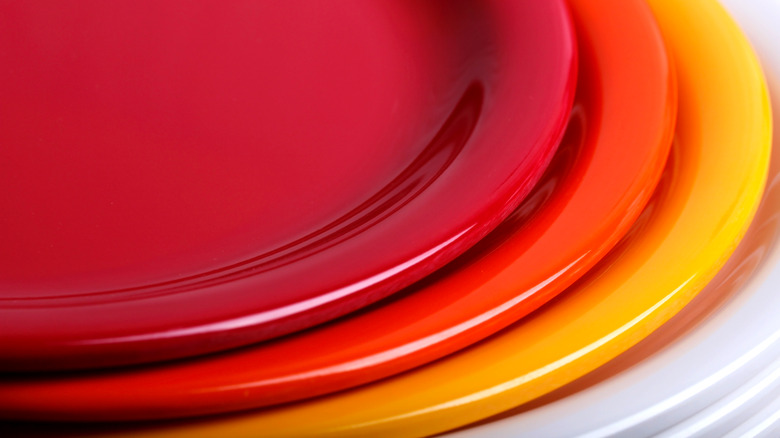Make Sure To Never Microwave Melamine Dishware, Here's Why
If you're like many people, you love melamine dishware's functionality, lightweight design, durability, and aesthetics. Before it becomes your favorite dish to pull out of the cupboard, though, think twice about placing it in the microwave. It's typically unsafe to use this type of dishware in the microwave because the chemicals within this plastic resin leach into your food, especially if done over time. The microwave's heating power can cause damage to the melamine as well, which makes it even more worrisome to use repeatedly since the plastic chemicals become more exposed as cracks and dings emerge.
Keep in mind that there are some types of microwave-safe melamine dishware on the market. A product may be marked specifically with "microwave safe" on it (often, microwave-safe melamine dishware is also dishwasher safe). Typically, these products are designed to handle the high temperatures in either of these environments without allowing damage to occur. They may also be Bisphenol A-free, which means they don't contain some of the most toxic plastic-based chemicals in them. Even if a melamine product is marked as microwave safe, however, we recommend using a glass or ceramic material for preparing foods or warming them up in the microwave over melamine. It could prolong the lifespan of your new favorite dishes while also helping to ensure there's no risk of contamination to your food.
What is melamine dinnerware and why should you use it so carefully?
Melamine is a common ingredient used in various plastic dishes, utensils, and plates. The U.S. Food & Drug Administration (FDA) shares specifics on what melamine is and what it means to your health. While it is approved for food-grade packaging, the FDA warns that some products manufactured overseas, specifically in China, have higher levels of melamine in them. These products, which are made with melamine-formaldehyde resin, have the ability to be molded into a wide range of tableware products.
The problem is that some of the chemical remains present in the plastic, which can leach out of the material itself at a very slow rate in the right environment. Typically, for this to happen, the temperatures must be extreme, and the exposure that could potentially cause illness must be reached. However, The FDA warns that acidic foods cooked to high temperatures above 160 degrees Fahrenheit can increase the risk of exposure to this toxin. As a result of this, they warn that any type of food or drink warmed in a microwave — which can reach these temperatures — should not be in melamine containers.
Making the decision to use melamine dinnerware
Here's the good news. You can safely use melamine dinnerware for serving the food that you've heated in the microwave or as dinnerplates in general. You can even pour your coffee into a mug made with this plastic material. That's because, at that point, the heat level is much lower, and the risk of exposure to toxic chemicals is far lower. It's safe to serve and use melamine plastic tableware. Just keep it out of the microwave and avoid heating it in any other fashion (like on a grill or stovetop).
If you've always used melamine in the microwave in the past, don't fret too much. Unless you have a high risk for health conditions or your doctor has warned you about potential concerns, you'll likely be okay. Toxic levels are highest in older plastics so as long as you're not using those, there's less risk to your health. Check the bottom of any plates or bowls you have to look for the microwave safe symbol or mark (which typiclaly looks like three wavey lines). If you don't see that, avoid putting them into the microwave.


